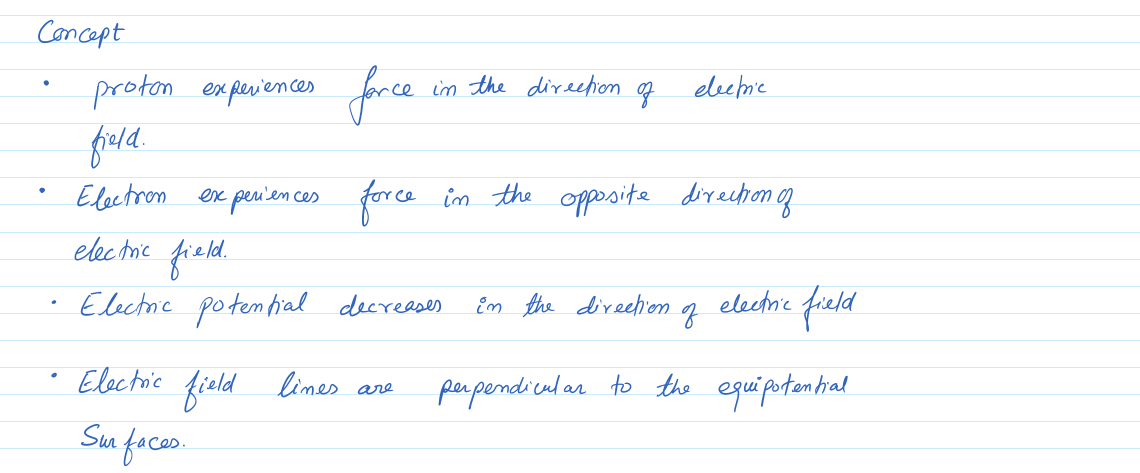A particle is freed from rest in a uniform electric field and then begins traveling under the influence of the electric field. Part (a) The particle is a proton. Which is true? Choose the best answer. Its potential energy increases and it begins traveling towards lower electric potential. Its potential energy increases and it begins traveling towards higher electric potential. Its potential energy decreases and it begins traveling towards lower electric potential. Its potential energy decreases and it begins traveling towards higher electric potential. Part (b) The particle is an electron. Which is true? Choose the best answer. Its potential energy decreases and it begins traveling towards lower electric potential. Its potential energy increases and it begins traveling towards higher electric potential. Its potential energy decreases and it begins traveling towards higher electric potential. Its potential energy increases and it begins traveling towards lower electric potential. Part (c) The particle is a proton. What is true about the proton’s path? Choose the best answer. The path is perpendicular to the electric field lines and perpendicular to the equipotential lines. The path is parallel to the electric field lines and parallel to the equipotential lines. The path is parallel to the electric field lines and perpendicular to the equipotential lines. The path is perpendicular to the electric field lines and parallel to the equipotential lines.
A particle is freed from rest in a uniform electric field and then begins traveling under the influence of the electric field. Part (a) The particle is a proton. Which is true? Choose the best answer. Its potential energy increases and it begins traveling towards lower electric potential. Its potential energy increases and it begins traveling towards higher electric potential. Its potential energy decreases and it begins traveling towards lower electric potential. Its potential energy decreases and it begins traveling towards higher electric potential. Part (b) The particle is an electron. Which is true? Choose the best answer. Its potential energy decreases and it begins traveling towards lower electric potential. Its potential energy increases and it begins traveling towards higher electric potential. Its potential energy decreases and it begins traveling towards higher electric potential. Its potential energy increases and it begins traveling towards lower electric potential. Part (c) The particle is a proton. What is true about the proton’s path? Choose the best answer. The path is perpendicular to the electric field lines and perpendicular to the equipotential lines. The path is parallel to the electric field lines and parallel to the equipotential lines. The path is parallel to the electric field lines and perpendicular to the equipotential lines. The path is perpendicular to the electric field lines and parallel to the equipotential lines.
College Physics
11th Edition
ISBN:9781305952300
Author:Raymond A. Serway, Chris Vuille
Publisher:Raymond A. Serway, Chris Vuille
Chapter16: Electrical Energy And Capacitance
Section: Chapter Questions
Problem 19P: A proton is located at the origin, and a second proton is located on the x-axis at x = 6.00 fm (1 fm...
Related questions
Question
100%
A particle is freed from rest in a uniform electric field and then begins traveling under the influence of the electric field.
| Part (a) The particle is a proton. Which is true? Choose the best answer. | ||||||
|
| Part (b) The particle is an electron. Which is true? Choose the best answer. | ||||||
|
| Part (c) The particle is a proton. What is true about the proton’s path? Choose the best answer. | ||||||
|
Expert Solution
Step 1

Trending now
This is a popular solution!
Step by step
Solved in 3 steps with 3 images

Knowledge Booster
Learn more about
Need a deep-dive on the concept behind this application? Look no further. Learn more about this topic, physics and related others by exploring similar questions and additional content below.Recommended textbooks for you

College Physics
Physics
ISBN:
9781305952300
Author:
Raymond A. Serway, Chris Vuille
Publisher:
Cengage Learning

Physics for Scientists and Engineers: Foundations…
Physics
ISBN:
9781133939146
Author:
Katz, Debora M.
Publisher:
Cengage Learning

College Physics
Physics
ISBN:
9781285737027
Author:
Raymond A. Serway, Chris Vuille
Publisher:
Cengage Learning

College Physics
Physics
ISBN:
9781305952300
Author:
Raymond A. Serway, Chris Vuille
Publisher:
Cengage Learning

Physics for Scientists and Engineers: Foundations…
Physics
ISBN:
9781133939146
Author:
Katz, Debora M.
Publisher:
Cengage Learning

College Physics
Physics
ISBN:
9781285737027
Author:
Raymond A. Serway, Chris Vuille
Publisher:
Cengage Learning

Principles of Physics: A Calculus-Based Text
Physics
ISBN:
9781133104261
Author:
Raymond A. Serway, John W. Jewett
Publisher:
Cengage Learning

Physics for Scientists and Engineers, Technology …
Physics
ISBN:
9781305116399
Author:
Raymond A. Serway, John W. Jewett
Publisher:
Cengage Learning